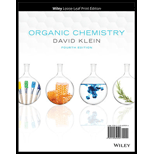
ORGANIC CHEMISTRY-PRINT (LL)-W/WILEY
4th Edition
ISBN: 9781119761105
Author: Klein
Publisher: WILEY
expand_more
expand_more
format_list_bulleted
Concept explainers
Question
Chapter 7.3, Problem 2LTS
Interpretation Introduction
Interpretation:
The transition state for the given mechanism is to be drawn:

Concept introduction:
In the
Expert Solution & Answer
Want to see the full answer?
Check out a sample textbook solution
Students have asked these similar questions
Lab Data
The distance entered is out of the expected range.
Check your calculations and conversion factors.
Verify your distance. Will the gas cloud be closer to the cotton ball with HCI or NH3?
Did you report your data to the correct number of significant figures?
- X
Experimental Set-up
HCI-NH3
NH3-HCI
Longer Tube
Time elapsed (min)
5 (exact)
5 (exact)
Distance between cotton balls (cm)
24.30
24.40
Distance to cloud (cm)
9.70
14.16
Distance traveled by HCI (cm)
9.70
9.80
Distance traveled by NH3 (cm)
14.60
14.50
Diffusion rate of HCI (cm/hr)
116
118
Diffusion rate of NH3 (cm/hr)
175.2
175.2
How to measure distance and calculate rate
For the titration of a divalent metal ion (M2+) with EDTA, the stoichiometry of the reaction is typically:
1:1 (one mole of EDTA per mole of metal ion)
2:1 (two moles of EDTA per mole of metal ion)
1:2 (one mole of EDTA per two moles of metal ion)
None of the above
Please help me solve this reaction.
Chapter 7 Solutions
ORGANIC CHEMISTRY-PRINT (LL)-W/WILEY
Ch. 7.2 - Prob. 1CCCh. 7.3 - Prob. 2CCCh. 7.3 - Prob. 1LTSCh. 7.3 - Prob. 3PTSCh. 7.3 - Prob. 4ATSCh. 7.3 - Prob. 2LTSCh. 7.3 - Prob. 5PTSCh. 7.3 - Prob. 6ATSCh. 7.3 - Prob. 7CCCh. 7.4 - Prob. 8CC
Ch. 7.5 - Prob. 9CCCh. 7.6 - Prob. 10CCCh. 7.6 - Prob. 11CCCh. 7.7 - Prob. 12PTSCh. 7.7 - Prob. 13PTSCh. 7.7 - Prob. 14ATSCh. 7.7 - Prob. 4LTSCh. 7.7 - Prob. 16ATSCh. 7.7 - Prob. 17CCCh. 7.7 - Prob. 18CCCh. 7.7 - Prob. 5LTSCh. 7.7 - Prob. 19PTSCh. 7.7 - Prob. 20ATSCh. 7.8 - Prob. 21PTSCh. 7.8 - Prob. 22ATSCh. 7.8 - Prob. 23CCCh. 7.8 - Prob. 24CCCh. 7.8 - Prob. 25CCCh. 7.8 - Prob. 26CCCh. 7.8 - Prob. 27CCCh. 7.9 - Prob. 7LTSCh. 7.9 - Prob. 29ATSCh. 7.9 - Prob. 30ATSCh. 7.9 - Prob. 31ATSCh. 7.10 - Prob. 32CCCh. 7.10 - Prob. 33CCCh. 7.10 - Prob. 34CCCh. 7.11 - Prob. 8LTSCh. 7.11 - Prob. 35PTSCh. 7.11 - Prob. 36PTSCh. 7.11 - Prob. 37ATSCh. 7.11 - Prob. 9LTSCh. 7.11 - Prob. 40PTSCh. 7.11 - Prob. 41ATSCh. 7.12 - Prob. 42CCCh. 7.12 - Prob. 43CCCh. 7.12 - Prob. 44CCCh. 7.12 - Prob. 45CCCh. 7.12 - Prob. 46CCCh. 7 - Prob. 47PPCh. 7 - Prob. 48PPCh. 7 - Prob. 49PPCh. 7 - Prob. 50PPCh. 7 - Prob. 51PPCh. 7 - Prob. 52PPCh. 7 - Prob. 53PPCh. 7 - Prob. 54PPCh. 7 - Prob. 55PPCh. 7 - Prob. 56PPCh. 7 - Prob. 57PPCh. 7 - Prob. 58PPCh. 7 - Prob. 59PPCh. 7 - Prob. 60PPCh. 7 - Prob. 61PPCh. 7 - Prob. 64PPCh. 7 - Indicate whether you would use NaOEt or tBuOK to...Ch. 7 - Prob. 68PPCh. 7 - Draw a plausible mechanism for each of the...Ch. 7 - Prob. 70PPCh. 7 - Prob. 71PPCh. 7 - Prob. 72PPCh. 7 - Prob. 73PPCh. 7 - Prob. 74PPCh. 7 - Prob. 77PPCh. 7 - Prob. 78PPCh. 7 - Prob. 81ASPCh. 7 - Prob. 87ASPCh. 7 - Prob. 90ASPCh. 7 - Prob. 91IPCh. 7 - Prob. 92IPCh. 7 - Prob. 93IPCh. 7 - Prob. 94IPCh. 7 - Prob. 95IPCh. 7 - Prob. 96IPCh. 7 - Prob. 97IPCh. 7 - Prob. 98IPCh. 7 - Prob. 99IPCh. 7 - Prob. 100IPCh. 7 - Prob. 101IPCh. 7 - Prob. 102IPCh. 7 - Prob. 103IPCh. 7 - Prob. 105IPCh. 7 - Prob. 106IPCh. 7 - Prob. 107IPCh. 7 - Prob. 109IPCh. 7 - Prob. 110CPCh. 7 - Prob. 112CPCh. 7 - Prob. 114CP
Knowledge Booster
Learn more about
Need a deep-dive on the concept behind this application? Look no further. Learn more about this topic, chemistry and related others by exploring similar questions and additional content below.Similar questions
- Indicate the products obtained by mixing 2,2-dimethylpropanal with acetaldehyde and sodium ethoxide in ethanol.arrow_forwardSynthesize 2-Ethyl-3-methyloxirane from dimethyl(propyl)sulfonium iodide using the necessary organic or inorganic reagents. Draw the structures of the compounds.arrow_forwardSynthesize 2-Hydroxy-2-phenylacetonitrile from phenylmethanol using the necessary organic or inorganic reagents. Draw the structures of the compounds.arrow_forward
- Synthesize N-Methylcyclohexylamine from cyclohexanol using the necessary organic or inorganic reagents. Draw the structures of the compounds.arrow_forwardSynthesize N-Methylcyclohexylamine from cyclohexanol using the necessary organic or inorganic reagents. Draw the structures of the compounds.arrow_forwardIf possible, please provide the formula of the compound 3,3-dimethylbut-2-enal.arrow_forward
- Synthesize 1,4-dibromobenzene from acetanilide (N-phenylacetamide) using the necessary organic or inorganic reagents. Draw the structures of the compounds.arrow_forwardIndicate the products obtained by mixing (3-oxo-3-phenylpropyl)triphenylphosphonium bromide with sodium hydride.arrow_forwardWe mix N-ethyl-2-hexanamine with excess methyl iodide and followed by heating with aqueous Ag2O. Indicate the major products obtained.arrow_forward
- Indicate the products obtained by mixing acetophenone with iodine and NaOH.arrow_forwardIndicate the products obtained by mixing 2-Propanone and ethyllithium and performing a subsequent acid hydrolysis.arrow_forwardIndicate the products obtained if (E)-2-butenal and 3-oxo-butanenitrile are mixed with sodium ethoxide in ethanol.arrow_forward
arrow_back_ios
SEE MORE QUESTIONS
arrow_forward_ios
Recommended textbooks for you
 Organic ChemistryChemistryISBN:9781305580350Author:William H. Brown, Brent L. Iverson, Eric Anslyn, Christopher S. FootePublisher:Cengage Learning
Organic ChemistryChemistryISBN:9781305580350Author:William H. Brown, Brent L. Iverson, Eric Anslyn, Christopher S. FootePublisher:Cengage Learning

Organic Chemistry
Chemistry
ISBN:9781305580350
Author:William H. Brown, Brent L. Iverson, Eric Anslyn, Christopher S. Foote
Publisher:Cengage Learning
